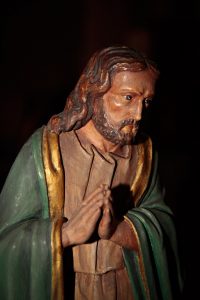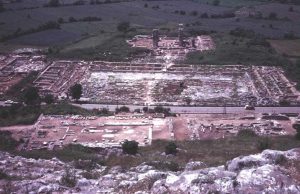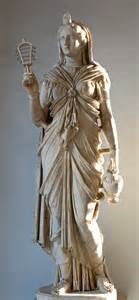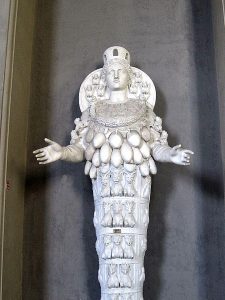Sometime in antiquity, a story developed that King Abgar V of Edessa, a Syrian city located in Mesopotamia, became ill, perhaps with leprosy, and wrote to Jesus of Nazareth to ask for a cure. In the correspondence, Abgar invited Jesus to come to Edessa to escape persecution. Jesus, according to the legend, replied in writing, praised Abgar’s faith, but told him that he could not visit Edessa. Jesus blessed the king in his return letter and vowed to send one of his disciples, after his ascension, to heal not only the king’s illness but also those of his subjects.
The story, according to bishop and church historian Eusebius of Caesarea in his Ecclesiastical History (I.13.5), continues: Shortly after Jesus’ resurrection and ascension, the Apostle Thomas sent the disciple Thaddeus to visit Edessa. After arriving and preaching in Edessa, Thaddeus was summoned before King Abgar, who became convinced that Jesus’ promise to him was being met. Thaddeus told Abgar that if he believed in Jesus’ message his prayers would be answered. Abgar assured Thaddeus that his belief was so strong that he had wanted his army to “destroy the Jews” for having Jesus killed; Abgar added that he had only restrained himself due to fear of Rome. (Of course, we must always note that it was not the Jews who crucified Jesus but the Romans.) Thaddeus told Abgar that Jesus’ crucifixion was the will of God and had to take place. Thaddeus then laid his hands on Abgar, miraculously curing him. Thaddeus went on to preach in Edessa and won some converts, and it was they who became the foundation of the church in Edessa.
Obviously this is a legend. It is highly unlikely that any King Abgar of Edessa directly corresponded with Jesus of Nazareth. Abgar V of Edessa lived from ca. 4 BCE to 50 CE, contemporary with Jesus, but there are a number of scholarly theories about the legend’s origin. It may have originated sometime after the conversion of Abgar IX, who lived between 179 and 214 CE, and there are others.
This correspondence between Abgar and Jesus is attested in both literary and archaeological sources from antiquity. If merely a legend, why might it have been preserved (in several languages) as the church grew, and why was it used in a number of ways, which we will explore below? What if anything might it say to us today? Here we will provide an introduction to the correspondence and start to answer these questions.  In Part II we will look more specifically at the example of the letters that were found in archaeological excavations at Philippi in northern Greece. We will see that the Abgar-Jesus legend and its several manifestations say interesting and challenging things to us about the nature and mission of Jesus, healing, and the richness of Christian belief and practice in the ancient world.
In Part II we will look more specifically at the example of the letters that were found in archaeological excavations at Philippi in northern Greece. We will see that the Abgar-Jesus legend and its several manifestations say interesting and challenging things to us about the nature and mission of Jesus, healing, and the richness of Christian belief and practice in the ancient world.
The Literary and Archaeological Evidence
Several examples of the Abgar-Jesus correspondence – whether containing both parts of the exchange or only one – have been found in archaeological contexts. The first of these examples discovered was written on a Coptic tomb in the service of a church in the Nubian desert west of Faras, a city in southern Egypt (present-day Sudan). The second find was on a door lintel of a house at Ephesus, an important early Christian city in present-day Turkey, and the third and fourth finds were from Gurdja (located in northern Anatolia). The fifth example was found in a grotto west of Edessa. One of the finds from Gurdja contained only Jesus’ response, as did the example from Edessa, which was written in Greek.
At Philippi in northern Greece, the Abgar-Jesus letters were found on an amulet near an altar bearing a dedication to the Egyptian Goddess Isis, entrusting the city to her protection; the altar had been moved in antiquity to its archaeological find-spot near the southeast gate of the city on the road leading to the port city of Neapolis.  This was the sixth archaeological example of the correspondence and only the third that contains both parts of the exchange. The Ephesian text, both examples from Gurdja and the Philippian version all contain a clause referring to the inviolability of the city, while the others were primarily concerned with personal protection, especially against sickness and evil.
This was the sixth archaeological example of the correspondence and only the third that contains both parts of the exchange. The Ephesian text, both examples from Gurdja and the Philippian version all contain a clause referring to the inviolability of the city, while the others were primarily concerned with personal protection, especially against sickness and evil.
Eusebius’ version, summarized above, is the earliest literary attestation in antiquity. Eusebius states that he has received the letters from the archives of Edessa. Twentieth-century church historian Walter Bauer theorized that the legend was started by the “orthodox” Bishop Kûne around 313 CE and “planted” in Eusebius’ sources to establish the heritage of Edessa as he saw it, in stark contrast to the truth – that Edessa was a heretical Christian community throughout most of its history. This is one of the several theories of the legend’s origin.
Once it was promulgated by Eusebius, the legend “enjoyed the widest dissemination in the domain of the Syriac, Armenian, Greek, Latin, Arabic, Persian, Slavonic and Coptic languages,” in the words of Bauer. It rapidly became used as an amulet against evil by both individuals and entire cities. Attestations of one part or another of the letters appear on parchments, pottery shards, door lintels and tombs. One early legend from Edessa testified that the mere reading of Jesus’ letter at the city gate, when the enemy was about to besiege the city in ca. 400 CE, caused the enemy to disperse; in fact, it was at Edessa because of this miracle that the practice of writing the inscriptions on city gates began.
The letters’ miraculous powers became known far and wide, and people and cities used them to ward off not only illness and invaders but also pagan beliefs, heretics and Jews. The practice of asking a deity to protect one’s city in this way was a long-standing pagan tradition and not unique to Christianity.  The existence of many niches in city walls for statues, icons and inscriptions indicates an ancient heritage of gods and goddesses being called upon to protect their cities. One place where such usage was intense was Thasos in northern Greece, where the goddess, probably Artemis of Ephesus, was invoked for protection on city gates, the acropolis and public monuments. Other gods similarly invoked as late as the sixth century include Herakles and Dionysos.
The existence of many niches in city walls for statues, icons and inscriptions indicates an ancient heritage of gods and goddesses being called upon to protect their cities. One place where such usage was intense was Thasos in northern Greece, where the goddess, probably Artemis of Ephesus, was invoked for protection on city gates, the acropolis and public monuments. Other gods similarly invoked as late as the sixth century include Herakles and Dionysos.
Another literary version of the Abgar letter is found in an early fifth-century Syriac document called the Doctrina Addai. In this manuscript, King Abgar, after learning from his servants that Jesus is performing healings in Palestine, sends a letter to Jesus inviting him to Edessa to heal his illness and to protect him from the hostility of the Jews. Jesus’ response, that his work on earth is almost done and that, after his resurrection and ascension he will send one of his apostles to heal him, is not written but rather comes verbally via Hanan the archivist.
Jesus then sends the apostle Addai, or Thaddeus. He heals not only Abgar but also many others; the point is made in the text that he uses no drugs. The healings, along with other miracles, cause many pagans to be converted to Christianity and churches to be built at Edessa, a part of the legend that we noted above. The overall tone of the correspondence in the Doctrina Addai is anti-pagan and anti-Jewish, as well as against divination, horoscopes and zodiac signs. The theme of the city’s protection is used on numerous occasions in the manuscript – “may the enemy never prevail over it” (Howard, Addai, 57) – and Jesus’ response ends similarly: “As for your city, may it be blessed and may no enemy ever again rule over it” (Howard, Addai, 9).
Yet another literary attestation of the Abgar-Jesus correspondence is the pilgrim Etheria’s (or Egeria’s) reference to a Syriac version of Jesus’ letter preserved on parchment and housed at Edessa. “The Pilgrimage of Etheria,” a narration of the abbess’ journey to Egypt, the Holy Land, Edessa, Asia Minor and Constantinople, was written around the end of the fourth century.
Some accounts of the Abgar-Jesus story that circulated in antiquity relate that Jesus also sent, along with the letter, a portrait of himself miraculously imprinted on canvas or painted by Hanan the archivist, depending on the version of the story. The portrait (called the Mandylion), like the letter, was believed to have apotropaic (preventative) powers.
Significance
 As we can see, the Abgar-Jesus correspondence was very popular in the ancient world, in some communities and at certain times. Like many other stories that circulated as Christianity grew, which were far removed from the canonical Gospels, is evidence of the rich variety of Christian belief and practice in the first several centuries. Even as Christianity headed toward some level of “orthodoxy,” Christians had many ideas about the meaning of Jesus and his mission.
As we can see, the Abgar-Jesus correspondence was very popular in the ancient world, in some communities and at certain times. Like many other stories that circulated as Christianity grew, which were far removed from the canonical Gospels, is evidence of the rich variety of Christian belief and practice in the first several centuries. Even as Christianity headed toward some level of “orthodoxy,” Christians had many ideas about the meaning of Jesus and his mission.
In the legend, Jesus was revered as a healer, by King Abgar and those who disseminated the legend; of course, stories of Jesus healing permeate the Gospels. Importantly, healing was a major function of many deities in the ancient world, so the legend’s and the Gospels’ focus on healing parallels that of contemporary stories and legends. We will look at this more closely in Part II.
The use of the stories as an amulet against evil, and even being placed on city gates, demonstrates the story’s presumed power and efficacy in the eyes of those who believed.
In addition, the legend relates that Jesus promises to send one of his followers to visit Abgar and conduct the healing. It is interesting to have a story in which Jesus refuses a request, especially that of a ruler. What if anything is the significance of that aspect and of Jesus’ apostle sending to Abgar a substitute to perform the healing? Might ancient hearers of the legend have understood that they, as those who revered Jesus, were called to be healers? Or do the important roles of Thomas and Thaddeus serve primarily to confirm the supposed history of Christianity in this part of the world?
 Finally, the story has Jesus predicting his ascension into heaven. Obviously this is a theological accretion, not something that a normal human being would be able to do or to predict. It is this part of the story that helps convince us that this is legend, not history. Jesus’ divine nature places us firmly in the realm of church doctrine – not just that Jesus was a great teacher and healer but also that he was the Christ, the Anointed One, and the Savior. This, of course, is to be expected more than two centuries after Jesus’ death.
Finally, the story has Jesus predicting his ascension into heaven. Obviously this is a theological accretion, not something that a normal human being would be able to do or to predict. It is this part of the story that helps convince us that this is legend, not history. Jesus’ divine nature places us firmly in the realm of church doctrine – not just that Jesus was a great teacher and healer but also that he was the Christ, the Anointed One, and the Savior. This, of course, is to be expected more than two centuries after Jesus’ death.
In Part II, we will turn to the version of the Abgar-Jesus legend that was found at Philippi in northern Greece. There we will examine the artifact’s and the legend’s legacy for healing, magic, pagan religion and early Christianity.
Note: A version of this post originally appeared in Abrahamsen, Goddess and God, pages 86-94.
Resources
“Abgar, Legend of,” in F.L. Cross and E.A. Livingstone, eds., The Oxford Dictionary of the Christian Church, 5. Oxford: Oxford University Press, 1983.
Abrahamsen, Valerie A. Goddess and God: A Holy Tension in the First Christian Centuries. Marco Polo Monographs 10. Warren Center, PA: Shangri-La Publications, 2006.
Abrahamsen, Valerie A. The Rock Reliefs and the Cult of Diana at Philippi. Harvard University dissertation, 1986; Ann Arbor, Mich.: University Microfilms, Inc., 1986.
“Addai,” in F.L. Cross and E.A. Livingstone, eds., The Oxford Dictionary of the Christian Church, 16. Oxford: Oxford University Press, 1983.
Bauer, Walter. “The Abgar Legend,” in Edgar Hennecke and Wilhelm Schneemelcher, eds., New Testament Apocrypha, Vol. I, 438. Philadelphia: Westminster Press, 1963.
Bauer, Walter. Orthodoxy and Heresy in Earliest Christianity, ed. Robert A. Kraft and Gerhard Krodel. Philadelphia: Fortress, 1971; German original, Rechtglaubigkeit und Ketzerei im ältesten Christentum. Tübingen: Mohr/Siebeck, 1934.
Betz, Hans Dieter. “Magic: Magic in Greco-Roman Antiquity,” in Mircea Eliade, editor-in-chief, Encyclopedia of Religion, Vol. 9, 93-97. New York: Macmillan Publishing Co., 1987.
Enslin, M.S. “Abgarus, Epistles of Christ and,” in Interpreter’s Dictionary of the Bible, Vol. I, 5. New York and Nashville: Abingdon Press, 1962.
“Etheria, Pilgrimage of,” in F.L. Cross and E.A. Livingstone, eds., The Oxford Dictionary of the Christian Church, 473. Oxford: Oxford University Press, 1983.
Feissel, Denis. Recueil des inscriptions chrétiennes de Macédoine du IIIe au VIe siècle. Athens and Paris: Bulletin de Correspondance Hellénique Supplement 8, 1983.
Howard, George, trans. The Teaching of Addai. Chico, CA: Scholars Press, 1981.
Jones, Christopher. “The Letters of Abgar V,” https://gatesofnineveh.wordpress.com/2011/08/04/the-letters-of-abgar-v/; accessed 12/10/20.
McVey, Kathleen E. “Abgar, Epistle of Christ to,” Anchor Bible Dictionary, Vol. 1, 12. New York: Doubleday, 1992.
Picard, Charles. “Un texte nouveau de la correspondance entre Abgar D’Osroène et Jésus-Christ gravé sur une porte de ville, à Philippes (Macédoine),” Bulletin de Correspondance Hellénique 44 (1920) 41-69.
Youtrie, Herbert C. “A Gothenburg Papyrus and the Letter to Abgar,” Harvard Theological Review 23 (1930) 302.
